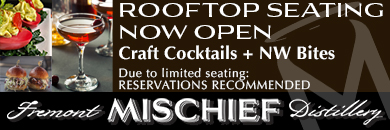by Kirby Lindsay
This column was originally published in The Seattle Press on December 29, 1999.
“What’s in a name? That which we call a rose/By any other name would smell as sweet.” wrote William. Shakespeare. Would it? Would Fremont still be ‘Fremont’ if it were called the Lake District?
In The Beginning
At History House, our local museum, I stumbled across a wonderful article written by Millie Klassert. I was fascinated to find out origins of many street names in Fremont.
For instance, many streets had Greek names like Remus, Nestor, Nero, Jupiter, Juno, and Hector. Then, in 1888, the area was replatted and the names were changed. Draco became Linden, Pandora became Palatine, Pallas switched to Greenwood, Creon to Dayton and Dion to Whitman.
Then Came The ‘Founders’
The changes were made when the area was ‘founded’ by M. Edward Blewett, L.H. Griffith, and Edward Corliss Kilbourne.
Blewett, from Fremont, Nebraska, held a strong fondness for his home town. In its honor, he called the 240 acres he purchased for $55,000 from John Hoyt ‘Fremont’. (Contrary to popular opinion, we are NOT named after General Fremont although the town in Nebraska is.)
Kilbourne was raised in Aurora, Illinois and gave us Aurora Avenue.
Bowdoin Place may also reflect someone’s fondness for home being named either for the town of Bowdoin or Bowdoin College, both in Maine.
Kilbourne’s uncle, Corliss P. Stone, owned land east of Fremont, possibly the site of our major arterial, Stone Way. Corliss Avenue is also named after him. John Leary, who owned land just north of Fremont, has the distinction of Leary Way, another major arterial.
Next Arrived The Fremonsters
I’ve always found it telling that Blewett, our ‘founder’, quickly lost interest in the town he started, and chose to return to Nebraska. The area easily filled with an odd assortment of people drawn here by what we now describe as the “pull of the Center of the Universe”.
They often arrived by the streetcar franchise started by Kilbourne and Griffith. It eventually connected with Guy C. Phinney’s Woodland Park Line. Besides giving the City the Woodland Park Estate, where the Zoo was built, he gave us Woodland Park Avenue and Phinney Avenue.
In the early 1900’s, the Seattle Engineering Department attempted to simplify things. Streets that flowed between neighborhoods – many of which had once been towns like Fremont, Ballard and Ross – were named once rather than changing at the boundary of each neighborhood. Also, many streets, like Blewett and Kilbourne, were changed to numbers. In this case, 35th & 36th, respectively. The original Fremont Avenue was changed to 38th Street so the main thoroughfare, Lake Street, became Fremont Avenue.
Motor Place was the street where one of the streetcar lines ran, and near where many of the streetcars were repaired. Canal Street running along the water was probably named for the Lake Washington Ship Canal, but that is only a guess.
Changing History
Unfortunately, most of this information must be laboriously dug up or blindly guessed at. According to Scott Cline, City of Seattle Historian, all a street naming, or name change, requires is a date and ordinance number. There is no requirement to explain the change, what the original name might have been or whom is being immortalized with the honor.
The Burke-Gilman bike trail, which runs through Fremont, is named after Judge Thomas Burke and Daniel Gilman. These two men led the way to establish a Seattle railroad. Judge Burke was a major force in early Seattle history, and has Burke Avenue and the Burke Museum named after him as well.
In Fremont we have a family named Burke that came to prominence within the last 50 years. There is no relationship between the two families; the name Burke is very common in English and Irish history. Still, many people re-write history from a current perspective because information on the past may be hard to find.
The Fremont Neighborhood Plan contains a request to change one current street name. This one won’t eradicate a piece of history, but it may give mapmakers a major headache. Where the Aurora Bridge meets the land, before it arches over Fremont, the Fremont Arts Council built the Fremont Troll. Three blocks of street still lay beneath the bridge and are still referred to as “Aurora”. Many suggest we call this stretch, often referred to as the Hall of Giants, Troll Way, to set it off from the street above. It would make it easier to find, except on maps. (Note: In 2005, the street was renamed ‘Troll Avenue North’.)
It might also cause a puzzle. In the far off future, when the Troll has been reduced to rubble, by an apocalyptic earthquake or a movement to destroy all symbols of whimsy. There might be a columnist like me who suggests the name ‘Troll Way’ came from a town in Texas or out of our maritime past.
It could happen.
Thank you to Millie Klassert for the article that inspired this one.
©2011 Kirby Lindsay. This column is protected by intellectual property laws, including U.S. copyright laws. Reproduction, adaptation or distribution without permission is prohibited.

